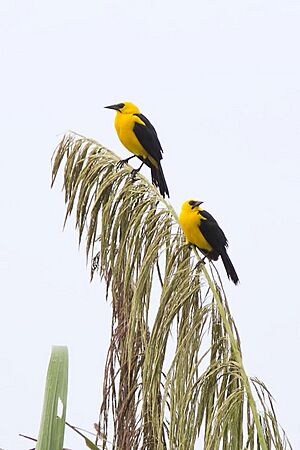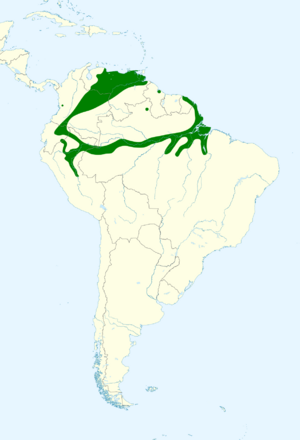Oriole blackbird facts for kids
Quick facts for kids Oriole blackbird |
|
|---|---|
 |
|
| In Peru | |
| Conservation status | |
| Scientific classification | |
 |
|
| Synonyms | |
|
The oriole blackbird (Gymnomystax mexicanus) is a cool bird from the Icteridae family. It's a medium-sized bird with bright yellow and black feathers. You can find these birds in parts of South America, like Brazil, Colombia, and Venezuela. They love to live in places like wet forests, bushy areas, grasslands that get flooded, and swamps. This bird is the only one in its group, called Gymnomystax.
Contents
About the Oriole Blackbird's Name
The oriole blackbird got its scientific name, Oriolus mexicanus, from a famous Swedish scientist named Carl Linnaeus in 1766. He thought it came from Mexico, but later it was found that it actually came from French Guiana.
Later, in 1850, a German scientist named Ludwig Reichenbach created a special group, or genus, just for this bird. He called it Gymnomystax. This name comes from ancient Greek words meaning "bare" and "moustache," which might refer to how the bird looks. The oriole blackbird is the only species in this Gymnomystax group.
What Does the Oriole Blackbird Look Like?
The oriole blackbird can grow to be about 30 cm (12 in) long. Both male and female birds look very similar.
Their heads, necks, shoulders, and undersides are a bright, sunny yellow. The rest of their bodies, like their backs, wings, and tails, are black. They have a small yellow stripe under their wings too. Their eyes are brown with a black ring around them. They also have a big black beak and black feet.
When they sing, they make loud, scratchy calls. It can sound like a rusty door hinge! They often call from high up in trees or while flying.
Where Do Oriole Blackbirds Live?
These birds live in the northern parts of South America. You can find them in countries like French Guiana, Guyana, Suriname, Venezuela, Colombia, Ecuador, Peru, and northern Brazil.
They like to live in grassy areas with a few trees, especially near rivers, marshes, or on islands in rivers. They also enjoy gallery forest, which are forests that grow along rivers.
Life and Habits of the Oriole Blackbird
Oriole blackbirds are usually seen in pairs or small groups. They don't often join up with other types of birds.
They like to sit in high places, like on small trees or the tops of bushes. They mostly look for food on the ground, especially in muddy spots near water.
What Do They Eat?
These birds eat many different things. They enjoy invertebrates like earthworms, caterpillars, and flying insects. They also eat small frogs and fruits. Sometimes, they even open up ripening corn cobs to eat the seeds inside!
Reproduction and Life Cycle
Oriole blackbirds usually breed in May and June. They build a nest that looks like a cup. It's about 17 cm (7 in) wide. They make it loosely from dry grass and plant stems, and then line it with small roots.
Their eggs are a pale blue color with black, brown, and purple spots. Sometimes, another bird called the shiny cowbird will lay its egg in an oriole blackbird's nest. This is called brood parasitism, where one bird tricks another into raising its young.
The female oriole blackbird sits on the eggs for about 18 days until they hatch. Both parents work together to feed the baby birds. They bring small invertebrates and frogs to the nest in their be beaks. They don't spit up the food; they bring it whole.
Conservation Status
The oriole blackbird is a fairly common bird. It lives in a very large area, and its numbers seem to be staying steady. Because of this, the International Union for Conservation of Nature says that its conservation status is "least concern." This means they are not worried about this bird becoming endangered anytime soon.


